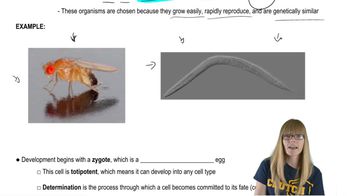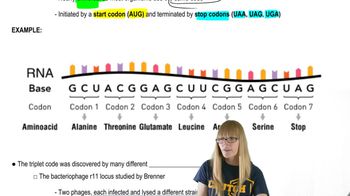Homeotic genes are thought to regulate each other. What aspect of the phenotype of apetala2 agamous double mutants indicates that these two genes act antagonistically?
Table of contents
- 1. Introduction to Genetics51m
- 2. Mendel's Laws of Inheritance3h 37m
- 3. Extensions to Mendelian Inheritance2h 41m
- 4. Genetic Mapping and Linkage2h 28m
- 5. Genetics of Bacteria and Viruses1h 21m
- 6. Chromosomal Variation1h 48m
- 7. DNA and Chromosome Structure56m
- 8. DNA Replication1h 10m
- 9. Mitosis and Meiosis1h 34m
- 10. Transcription1h 0m
- 11. Translation58m
- 12. Gene Regulation in Prokaryotes1h 19m
- 13. Gene Regulation in Eukaryotes44m
- 14. Genetic Control of Development44m
- 15. Genomes and Genomics1h 50m
- 16. Transposable Elements47m
- 17. Mutation, Repair, and Recombination1h 6m
- 18. Molecular Genetic Tools19m
- 19. Cancer Genetics29m
- 20. Quantitative Genetics1h 26m
- 21. Population Genetics50m
- 22. Evolutionary Genetics29m
14. Genetic Control of Development
Developmental Patterning Genes
Problem 26a
Textbook Question
In land plants, there is an alternation of generations between a haploid gametophyte generation and a diploid sporophytic generation. Both generations are typically multicellular and may be free-living. The male (pollen) and female (embryo sac) gametophytes are the haploid generation of flowering plants.
How would you conduct a screen to identify genes required for female gametophyte development in Arabidopsis?
 Verified step by step guidance
Verified step by step guidance1
Understand the biological context: Female gametophyte development in Arabidopsis involves the formation of the embryo sac, which is a haploid structure derived from meiosis of the megaspore mother cell. Genes involved in this process are critical for proper development and function of the gametophyte.
Design a genetic screen: Use mutagenesis (e.g., chemical mutagens like EMS or insertional mutagenesis using T-DNA) to induce random mutations in Arabidopsis seeds. Grow the plants to maturity to allow the mutations to be expressed in the next generation.
Identify mutants with defective female gametophyte development: Screen for plants that exhibit abnormalities in seed development, reduced fertility, or defects in embryo sac formation. This can be done by observing ovules under a microscope to check for structural or developmental abnormalities.
Confirm the genetic basis of the phenotype: Perform genetic crosses to determine if the observed defects are heritable and linked to a single gene. For example, cross the mutant plants with wild-type plants and analyze the segregation patterns in the progeny.
Map and identify the gene: Use molecular techniques such as positional cloning or whole-genome sequencing to identify the specific gene responsible for the mutant phenotype. Once identified, validate the gene's role in female gametophyte development by complementing the mutant with a wild-type copy of the gene or using gene-editing techniques like CRISPR to recreate the mutation.
 Verified video answer for a similar problem:
Verified video answer for a similar problem:This video solution was recommended by our tutors as helpful for the problem above
Video duration:
3mPlay a video:
Was this helpful?
Key Concepts
Here are the essential concepts you must grasp in order to answer the question correctly.
Alternation of Generations
Alternation of generations is a reproductive cycle in land plants that involves two distinct multicellular stages: the haploid gametophyte and the diploid sporophyte. The gametophyte produces gametes through mitosis, while the sporophyte produces spores through meiosis. Understanding this cycle is crucial for identifying the genetic mechanisms that govern the development of each generation, particularly the female gametophyte in flowering plants.
Recommended video:
Guided course

Alternative DNA Forms
Gametophyte Development
Gametophyte development refers to the processes by which haploid structures, such as pollen and embryo sacs, form and mature in plants. In Arabidopsis, the female gametophyte develops within the ovule and undergoes several stages, including megasporogenesis and megagametogenesis. Identifying genes involved in this development can provide insights into the genetic regulation of reproductive processes in flowering plants.
Recommended video:
Guided course

Genetics of Development
Genetic Screening Techniques
Genetic screening techniques, such as mutagenesis, gene knockout, and transgenic approaches, are essential for identifying specific genes involved in biological processes. In the context of Arabidopsis, researchers can use these techniques to create mutants or analyze gene expression patterns during female gametophyte development. This allows for the identification of key genes that influence the formation and function of the female gametophyte.
Recommended video:
Guided course

The Genetic Code
Related Videos
Related Practice
Textbook Question
595
views


